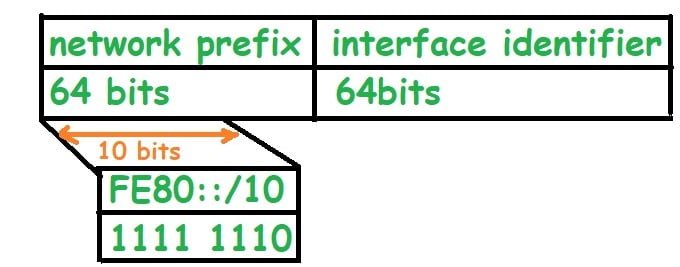In this post, we will discuss everything about the IPv6 address in networking.
What is IPv6?
According to Wikipedia
IPv6 is an Internet Layer protocol for packet-switched internetworking and provides end-to-end datagram transmission across multiple IP networks, closely adhering to the design principles developed in the previous version of the protocol, Internet Protocol Version 4 (IPv4).
IPv6 Characteristics
- 16 bytes or 128 bits.
- IPv6 address comprises of 16 octets i.e total 128 bits. Example: 021A:D300:0000:2BF3:02AA:0FF0:FE28:9C5A
- 3.8×10^38 ip address available.
- Case insensitive g or G doesn’t matter.
- 3001:0000:4321 could be written as 3001:0:4321
- 2001:0000:0000:3214 could be written as 2001::3214
- 2001::1236::1536 (wrong notation) because twice colon is not applicable, hence it becomes difficult for the system to identify whether it is 4 zeroes or 8 zeroes.

Some Examples:
- Example of loopback Address – 0:0:0:0:0:0:0:1=::1
- Example of unassigned Address – 0:0:0:0:0:0:0:0=::
Surfing the web
In a URL, we usually enclose IPv6 address in brackets (e.g http://[2002:321:6532::6]:4056/index.html). It is mostly used for diagnostic purpose and is not user friendly.
Note: to test your ipv6 connectivity you can go to test-ipv6.com.
why we don’t need NAT in case of ipv6?
There is no need for NAT in ipv6 as NAT was introduced to try and conserve ipv4 for address yet we have plenty of address, so there’s no need for NAT.
Ipv6 Address Types
1. UNICAST (one to one)
- Address for a single interface.
- Several types like global unicast address reserved unicast address.
- Link local unicast address: routers do not forward link-local address as it will allow two hosts to communicate with each other without IP address being assigned to those devices.
- Site local unicast address: assigned to an entire site within an organization. Deprecated since 2004 no longer use of because of confusion and ambiguity.
- Special purpose unicast: unspecified,loopback,ipv4 compatible.
2. MUTICAST (one to multiple)
- Enables more efficient use of the network.
- Uses a larger address range.
3. ANYCAST (one to nearest)
- Allocated from unicast address space.
- Multiple devices share the same address.
- At anycast nodes should provide uniform service.
- Routers decide an closest device to reach destination.
Note: Broadcast costs lots of issues on networks and broadcasting has been replaced with multicasting in an ipv6 environment. We no longer send broadcasts if we want to contact multiple devices then we have to send a multicast instead of a broadcast.
Difference Between IPv4 and IPv6 to Remember
IPv6 has some advantages over IPv4.
- No subnetting like ipv4.
- No NAT like ipv4.
- Each link will have a /64 subnet mask.
- Interface id can use a modified EUI-64 format.
- Uses a global routing prefix enables aggregation.
- Every ipv6 interface contains at least one loopback ::1/128.
- Optionally multiple unique local and global address.
- Aggregation/summarization more efficient.
IPv6 is actually broken up into more fields:

SLAD – Site Level Aggregation Identifier.
NLAID – Next Level Aggregation Identifier.
RES – Reserved.
TLAID – Top Level Aggregation Identifier.
FP – Format Prefix.
IPv6 Link-Local Address
- Have a scope limited to the link.
- Are automatically configured with the interface id
- IPv6 site-local address.
- Have a scope limited to the site.
- Contain the inside topology of the site with the subnet id.
- Have been deprecated.

IPv6 Routing Protocols
- Static
- Ripng (rfc 2080).
- Ospf v3.
- Is-Is for ipv6.
- Mp-bgp4(multi-protocol)
Note: The ipv6 unicast-routing command is required to enable ipv6 before any routing protocol is configured.
If you have any doubts or suggestion then comment below.